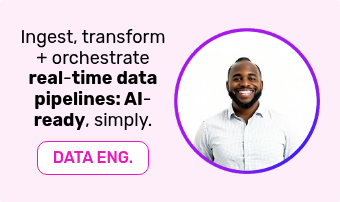In this article, we answer all of the questions that might have about IIoT, IoT platforms, software and solutions but were too afraid to ask.
What does IIoT stand for?
IIoT stands for Industrial Internet of Things.
IIoT is a catch-all term that refers generally to the combination of industrial equipment, hardware, and machinery with an Industrial IoT platform and its associated front-end software.
What is the difference between IoT vs IIoT?
They’re one and the same thing (sort of).
IoT refers to the ‘Internet of Things’, which describes things in the physical, real-world that are connected to the internet and exchange data across it. This could be an IoT sensor that measures temperature and displays the result on your mobile phone, a machine that has connectivity embedded that allows you to control it online (such as you air conditioner), or any number of the ‘Smart’ objects that you have in your home such as a fridge that knows when you’re out of milk and can order you some more without you asking it to.
The extra ‘I’ in ‘IIoT’ refers to the word ‘industrial, making it the ‘Industrial Internet of Things’. This refers to the application of IoT technology in the industrial world, such as in factories, mines, furnaces, machinery, nuclear reactors – or anywhere else! It allows businesses and their employees to monitor what’s going on in the real-world in real-time, both remotely and on-site, enabling people to affect change that improves the way something is operating, maintain safety, predict failures and much, much more.
Frequently with IIoT, the technology is coupled with software know as an IoT platform, that can collate all of a businesses IoT and other data streams to provide them with sophisticated additional Industry 3.0 and Industry 4.0 capabilities.
What is an Industrial IoT (IIoT) platform?
An Industrial IoT platform is a software platform that can collect real-time data from IoT sensors, plant and other machinery, couple it with other streams of data (such as coming ERP, SCADA, CRM systems) and other sources (spreadsheets, databases or anything else) to create a real-time single source of truth for a business which can be explored via dashboards or other tools.
What’s the difference between an IoT platform / Industrial IoT (IIoT) platform and an integrated data, AI + IoT platform?
A simple IoT platform will be capable of collating data streams from multiple sources, including real-world sensors and other systems, to create dashboards that allow people to explore real-time data.
An advanced IoT platform (often what is referred to when discussing IIoT platforms) will commonly have significantly more additional functionality. Typically it will include data manipulation, interpretation and verification tools; offer bi-directional real-time control functionality (leading to reactive and automation abilities); as well as a built-in machine learning module that allows for the creation or upload of algorithms that can predict performance and automatically make changes to machinery and systems to optimise it: GenAI (artificial intelligence).
Our Rayven platform offers the ability to integrate, manage, analyse and act on data in one solution, on-premise or in the cloud, eliminating the need for multiple modules or tools which is common with many platforms, such as with Google, Microsoft and other tool-kit-based cloud systems.
What is an IIoT solution or IIoT application?
An Industrial IoT solution or IIoT application refers to the configuration of an IoT platform (or our advanced IoT platform!) that’s designed for an individual (or multiple) industrial applications, such as real-time monitoring of people and/or machinery, predicting failures, finding optimisations, or anything else.
To function, it requires multiple layers of technology:
- Hardware/Sensors that measure or action things in the physical world
- Communications layer that transmits the data from hardware sensors to the platform
- Industrial and business management system integrations with the platform, e.g. with SCADA, BMS, CRM, ERP etc.
- The integrated data, AI + IoT platform that collates all the data, actions changes, leverage machine learning algorithms (the back-end)
- The software that sits on the platform that enables people to use the solution (the front-end)
What’s the difference between IoT vs Industry 4.0?
IoT technology is a critical component of what is referred to as Industry 4.0.
Industry 4.0 status is achieved when a business utilises an integrated data, AI + IoT platform solution to apply a machine learning algorithm to real-time data to predict future performance, find a more optimal way of doing it, and then change the things necessary to achieve that via automations. This then creates an ongoing optimisation feedback loop that requires minimal to no human intervention, but that is constantly improving the outcome of industrial processes.
Where IoT fits into it is in utilising real-world devices and machinery to collect the data that the machine learning algorithm uses and/or to then action the changes that it needs to make to improve performance.
How can you use an IoT platform?
An IoT platform can be configured into multiple solutions or applications and applied to multiple industrial scenarios to achieve many different outcomes.
Uses of an IoT platform include:
- Asset Monitoring & Utilisation
- Building & Facilities Management
- Energy Forecasting & Efficiency
- Fault & Anomaly Detection
- Farm Monitoring, Irrigation & Yield
- Fleet Tracking, Management & Efficiency
- HSE Compliance Monitoring & Management
- HVAC Monitoring, Efficiency & Control
- Operations Monitoring & Control
- Predictive Maintenance
- Production & Yield (OEE)
- Regulatory Compliance & Reporting
- Supply Chain Tracking & Optimisation
- Water Management & Quality Monitoring
- Yellow Goods Monitoring & Management
What is an IIoT company?
An IIoT company is a business that provides one (or more) of a wide array of technologies that are involved in the Internet of Things – the single or bi-directional transmission of data from machinery to software via the internet.
This could be the hardware that collects/receives data in the physical world, the technology that transmits it to the internet, or the platform (and associated software) that receives the data and collates and interprets it, takes action because of it – and much, much more.

Still have a question? Ask an expert - we're always happy to chat.
What is IIoT software?
IIoT software is a system that is designed to monitor, collect, analyse and act upon data from industrial equipment and machinery, such as sensors, valves and motors, in real-time.
IIoT software enables industrial businesses to improve operational efficiencies and production output, as well as predict potential equipment failures before they happen.
What to look for in an IIoT platform?
When selecting an IoT and AI platform, it’s critical to look for one that’s highly-interoperable, easy-to-deploy and use, plus that fits for your needs (do you need a simple IIoT platform or a hybrid iPaaS, Data, ETL, IoT, ETL, BI, App Development + PaaS platform).
You’ll also want a platform that’s powerful enough to handle the volume of data you’re looking to gather, process, and then act upon; and which can be hosted where you need it (on-premise, private or public cloud).
Every IIoT platform is different, so it’s important you find one that meets your unique requirements. Common functionality/features to look out for include:
- Customisable, responsive GUI – is it easy-to-use and interpret data, particularly in the field
- Flexibility and interoperability – what can it connect to and how easy is it to configure it to meet your precise needs
- Extensive libraries of preloaded IIoT device drivers and algorithms
- Multi-device deployment and management capabilities
- Cloud / on-premise deployment abilities
- End-to-end enterprise security
- Scalability and affordability – is it cheap to begin with and also at-scale
- Speed of deployment – rapid deployments (weeks) are critical to projects, as they enable you to collect real-world data fast, reducing risk
How does IIoT work?
IIoT uses real-time data to make informed decisions based on pre-defined or user custom algorithms. These then trigger real-time actions, such as alerts, notifications, automated responses, and automated workflows.
What value can Rayven’s hybrid iPaaS, Data, ETL, IoT, ETL, BI, App Development + PaaS platform add to an IoT deployment?
Rayven’s platform unified data management, analytics and business optimisation so that enterprises can operationalise IoT data and gain real-time intelligence and predictive insights. It can be deployed standalone (for monitoring, reporting, and real-time predictive analytics insights), or embedded into IoT solutions to provide more value (for real-time actions).
Get in contact with us if you have more to questions to ask or want to know how we can help you with you IIoT and Industry 4.0 business objectives.




























